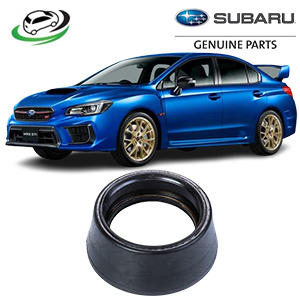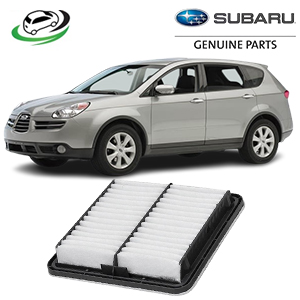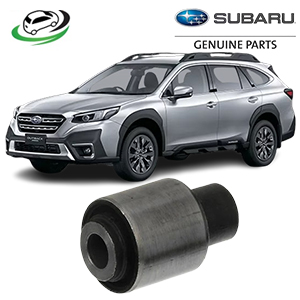-10%
Get Subaru Outback 2.5L Base 2018 Suspension Control Arm Bushing 20254AE040
The suspension control arm bushing is an essential component of a vehicle’s suspension system. It plays a critical role in connecting the control arm to the chassis of the vehicle, allowing for controlled movement and stability while driving. Understanding the functions, benefits, signs of failure, and maintenance of suspension control arm bushings is vital for any vehicle owner who wants to ensure optimal vehicle performance and safety.
1. What is a Suspension Control Arm Bushing?
A suspension control arm bushing is a cylindrical component typically made of rubber or polyurethane, designed to absorb shocks and vibrations while providing a pivot point for the control arm. The control arm itself is a crucial part of the vehicle’s suspension system, linking the wheels to the vehicle’s frame and allowing for controlled movement as the wheels travel over uneven surfaces.
The bushing is installed at the connection point between the control arm and the vehicle’s frame or subframe. It provides a flexible and cushioned interface that enables the control arm to move in multiple directions while minimizing harshness and noise transmitted to the vehicle’s cabin.
2. Functions of Suspension Control Arm Bushings
The primary functions of suspension control arm bushings include:
a. Vibration and Shock Absorption
The bushing acts as a cushion that absorbs vibrations and shocks from the road, preventing them from being transmitted directly to the vehicle’s frame. This contributes to a smoother ride, enhancing driver and passenger comfort.
b. Allowing Controlled Movement
Control arm bushings permit the control arm to pivot as the suspension system compresses and rebounds. This controlled movement is essential for maintaining wheel alignment and stability during cornering and braking.
c. Reducing Noise
The rubber or polyurethane material of the bushing dampens noise generated by road imperfections and suspension movement. This helps keep the cabin quieter, improving overall driving experience.
d. Protecting Suspension Components
By allowing controlled movement and absorbing shocks, bushings help protect other suspension components from premature wear and damage. They act as a first line of defense against impact forces.
3. Benefits of Properly Functioning Control Arm Bushings
Maintaining properly functioning suspension control arm bushings provides several benefits:
a. Improved Handling and Stability
When bushings are in good condition, they ensure that the control arm operates correctly, contributing to better handling and stability. This is particularly important during cornering and emergency maneuvers.
b. Enhanced Ride Quality
Functional bushings absorb vibrations and impacts, leading to a smoother ride. Passengers experience less jarring and a more comfortable journey, regardless of road conditions.
c. Reduced Tire Wear
Properly functioning bushings help maintain correct wheel alignment, reducing uneven tire wear. This extends the life of tires, ultimately saving you money on replacements.
d. Longer Suspension Component Lifespan
By reducing wear and tear on other suspension components, bushings can prolong the lifespan of the control arms, struts, and shocks. This results in fewer repairs and a more reliable suspension system.
e. Increased Safety
When suspension components work together as designed, the vehicle remains stable and predictable, especially during sudden maneuvers. This increases overall safety for the driver, passengers, and others on the road.
4. Signs of Failing Suspension Control Arm Bushings
Identifying worn or damaged control arm bushings early can prevent more extensive damage and costly repairs. Here are some common signs of failing bushings:
a. Clunking or Rattling Noises
One of the most noticeable signs of bad bushings is a clunking or rattling noise when driving over bumps or uneven surfaces. This occurs due to the loss of cushioning effect from the bushings, leading to metal-on-metal contact.
b. Poor Handling and Stability
If you notice that your vehicle feels unstable, wanders, or has a tendency to oversteer or understeer, it could be a sign of failing control arm bushings. Worn bushings can lead to improper wheel alignment and compromised handling.
c. Vibration in the Steering Wheel
Excessive vibration in the steering wheel while driving can indicate that the bushings are worn. This is particularly noticeable at higher speeds or when driving over uneven surfaces.
d. Uneven Tire Wear
Inspecting your tires for uneven wear patterns can provide insight into the condition of your suspension components. If the bushings are failing, they can cause the wheels to be misaligned, resulting in uneven tire wear.
e. Visual Inspection
A visual inspection of the bushings can also reveal cracks, tears, or significant wear. If the rubber is deteriorating or missing material, it’s time to consider replacement.
5. Maintenance of Suspension Control Arm Bushings
Proper maintenance of suspension control arm bushings is essential for extending their lifespan and ensuring optimal vehicle performance. Here are some tips for maintaining these components:
a. Regular Inspections
Include the control arm bushings in your routine vehicle inspections. Check for signs of wear, damage, or deterioration during regular maintenance or when performing oil changes.
b. Monitor Ride Quality
Pay attention to how your vehicle handles over time. If you notice any changes in ride quality, handling, or noise levels, it may indicate that your bushings need inspection or replacement.
c. Choose Quality Parts for Replacement
When replacing control arm bushings, choose high-quality parts that are designed for your specific make and model. Investing in quality bushings will provide better performance and longevity.
d. Consider the Material
Control arm bushings can be made of rubber, polyurethane, or even solid materials. While rubber bushings provide excellent ride quality, polyurethane bushings offer enhanced durability and performance, making them a popular choice for performance applications.
e. Professional Installation
If you are not experienced with suspension work, consider having a professional mechanic perform the inspection or replacement of control arm bushings. Proper installation is crucial for optimal performance.
6. Steps to Replace Suspension Control Arm Bushings
Replacing suspension control arm bushings involves several steps, which can vary depending on the vehicle make and model. Here’s a general outline of the process:
- Gather Necessary Tools and Equipment
You will need a jack, jack stands, wrenches, a torque wrench, and possibly a bushing removal tool. - Lift the Vehicle
Use a jack to lift the front or rear of the vehicle, depending on which control arm bushings need replacement. Secure the vehicle on jack stands for safety. - Remove the Wheel
Take off the wheel that corresponds to the control arm you’re working on to access the suspension components. - Disconnect the Control Arm
Depending on the design, you may need to disconnect the control arm from the chassis and the steering knuckle. This usually involves removing bolts or nuts using appropriate wrenches. - Remove Old Bushings
Use a bushing removal tool or press to remove the old bushings from the control arm. If the bushings are particularly stubborn, you may need to cut them out carefully. - Install New Bushings
Press or hammer the new bushings into the control arm, ensuring they are seated properly. - Reinstall the Control Arm
Reattach the control arm to the chassis and steering knuckle, tightening all bolts to the manufacturer’s specified torque settings. - Reinstall the Wheel
Put the wheel back on, and lower the vehicle to the ground. - Test Drive the Vehicle
After the replacement, take the vehicle for a test drive to ensure everything is functioning correctly and to check for any unusual noises or handling issues.
Conclusion
Suspension control arm bushings are vital components that significantly impact a vehicle’s ride quality, handling, and overall performance. Understanding their functions, benefits, and signs of failure can help you maintain your vehicle effectively. Regular inspections and timely replacements are essential to ensure the longevity of the suspension system and to enhance your driving experience. By staying proactive with maintenance, you can ensure that your vehicle remains safe and performs optimally on the road.
Follow us on Facebook for more parts.




Reviews
Clear filtersThere are no reviews yet.